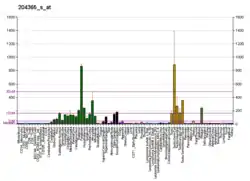| REEP1 | |||||||||||||||||||||||||||||||||||||||||||||||||||
|---|---|---|---|---|---|---|---|---|---|---|---|---|---|---|---|---|---|---|---|---|---|---|---|---|---|---|---|---|---|---|---|---|---|---|---|---|---|---|---|---|---|---|---|---|---|---|---|---|---|---|---|
| Identifiers | |||||||||||||||||||||||||||||||||||||||||||||||||||
| Aliases | REEP1, C2orf23, HMN5B, SPG31, Yip2a, receptor accessory protein 1 | ||||||||||||||||||||||||||||||||||||||||||||||||||
| External IDs | OMIM: 609139 MGI: 1098827 HomoloGene: 41504 GeneCards: REEP1 | ||||||||||||||||||||||||||||||||||||||||||||||||||
| |||||||||||||||||||||||||||||||||||||||||||||||||||
| |||||||||||||||||||||||||||||||||||||||||||||||||||
| |||||||||||||||||||||||||||||||||||||||||||||||||||
| |||||||||||||||||||||||||||||||||||||||||||||||||||
| |||||||||||||||||||||||||||||||||||||||||||||||||||
| Wikidata | |||||||||||||||||||||||||||||||||||||||||||||||||||
| |||||||||||||||||||||||||||||||||||||||||||||||||||
Receptor expression-enhancing protein 1 is a protein that in humans is encoded by the REEP1 gene.[5][6][7]
Clinical significance
Mutations in REEP1 are known to cause the following conditions:[8]
- Spastic paraplegia 31, autosomal dominant (SPG31);
- Neuronopathy, distal hereditary motor, 5B (HMN5B);
- Distal spinal muscular atrophy, autosomal recessive, 6 (DSMA6).
References
- 1 2 3 GRCh38: Ensembl release 89: ENSG00000068615 - Ensembl, May 2017
- 1 2 3 GRCm38: Ensembl release 89: ENSMUSG00000052852 - Ensembl, May 2017
- ↑ "Human PubMed Reference:". National Center for Biotechnology Information, U.S. National Library of Medicine.
- ↑ "Mouse PubMed Reference:". National Center for Biotechnology Information, U.S. National Library of Medicine.
- ↑ Clark AJ, Metherell LA, Cheetham ME, Huebner A (Nov 2005). "Inherited ACTH insensitivity illuminates the mechanisms of ACTH action". Trends Endocrinol Metab. 16 (10): 451–7. doi:10.1016/j.tem.2005.10.006. PMID 16271481. S2CID 27450434.
- ↑ Saito H, Kubota M, Roberts RW, Chi Q, Matsunami H (Nov 2004). "RTP family members induce functional expression of mammalian odorant receptors". Cell. 119 (5): 679–91. doi:10.1016/j.cell.2004.11.021. PMID 15550249. S2CID 13555927.
- ↑ "Entrez Gene: REEP1 receptor accessory protein 1".
- ↑ "UniProt". www.uniprot.org. Retrieved 2023-07-08.
Further reading
- Strausberg RL, Feingold EA, Grouse LH, et al. (2003). "Generation and initial analysis of more than 15,000 full-length human and mouse cDNA sequences". Proc. Natl. Acad. Sci. U.S.A. 99 (26): 16899–903. Bibcode:2002PNAS...9916899M. doi:10.1073/pnas.242603899. PMC 139241. PMID 12477932.
- Ota T, Suzuki Y, Nishikawa T, et al. (2004). "Complete sequencing and characterization of 21,243 full-length human cDNAs". Nat. Genet. 36 (1): 40–5. doi:10.1038/ng1285. PMID 14702039.
- Ballif BA, Villén J, Beausoleil SA, et al. (2005). "Phosphoproteomic analysis of the developing mouse brain". Mol. Cell. Proteomics. 3 (11): 1093–101. doi:10.1074/mcp.M400085-MCP200. PMID 15345747.
- Gerhard DS, Wagner L, Feingold EA, et al. (2004). "The status, quality, and expansion of the NIH full-length cDNA project: the Mammalian Gene Collection (MGC)". Genome Res. 14 (10B): 2121–7. doi:10.1101/gr.2596504. PMC 528928. PMID 15489334.
- Hillier LW, Graves TA, Fulton RS, et al. (2005). "Generation and annotation of the DNA sequences of human chromosomes 2 and 4". Nature. 434 (7034): 724–31. Bibcode:2005Natur.434..724H. doi:10.1038/nature03466. PMID 15815621.
- Behrens M, Bartelt J, Reichling C, et al. (2006). "Members of RTP and REEP gene families influence functional bitter taste receptor expression". J. Biol. Chem. 281 (29): 20650–9. doi:10.1074/jbc.M513637200. PMID 16720576.
- Züchner S, Wang G, Tran-Viet KN, et al. (2006). "Mutations in the novel mitochondrial protein REEP1 cause hereditary spastic paraplegia type 31". Am. J. Hum. Genet. 79 (2): 365–9. doi:10.1086/505361. PMC 1559498. PMID 16826527.
This article is issued from Wikipedia. The text is licensed under Creative Commons - Attribution - Sharealike. Additional terms may apply for the media files.





